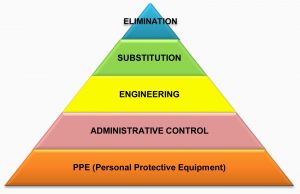When it comes to the safety and health of your employees, it pays to be proactive. When evaluating your business to identify any hazards that might pose a risk to your employees, ask yourself the following questions:
- What hazards are there in my workplace?
- How serious are these hazards?
- What can I do to control these hazards?
Identifying hazards
There are three basic areas that can introduce risk factors in the workplace:
Things you do: When engaging in day-to-day activities, employees are at risk by the actions they execute, the environment in which they work and the nature of the equipment they use. Examples might be handling dangerous equipment, repetitive movements, air quality and sitting with a bad posture.
Things you buy: The equipment and products you buy for the day-to-day running of your business may pose dangers for your employees. Examples would be chemicals such as chlorine at a gym, cleaning agents and heavy or sharp equipment.
Other people: Your employees will inevitably interact with colleagues or customers, exposing them to a vast array of potential risks. Examples may include abusive customers, renovators with dangerous equipment or co-workers who are ill, e.g. having the flu and making everyone else in the office sick.
You can identify potential risks to your employees by having regular inspections, checking previous incidence reports and engaging with your employees to get their valuable input – after all, they have a much better idea of what goes on at grass roots level.
Once you have identified potential risks, you must assess each risk.
Risk assessment
You need to determine the odds of an employee being affected by the hazard as well as the severity of the exposure.
Assess the risk by considering the following elements:
- The type of hazard.
- The severity of the hazard – How bad will the injury be or how much harm can be caused?
- The likelihood of the hazard resulting in severe consequences.
- The possibility, frequency and length of exposure to the hazard.
- Which employees may be affected by the hazard.
- The company’s abilities to deal with this hazard.
- The skills and experience of the people who will be exposed to this hazard.
- The set-up and condition of the workplace.
Risk control
Now that you have identified where the hazards are and how serious the risk they pose, you must decide on a plan of action on how you might best eliminate or reduce the risk.
The Hierarch of Hazard Control is a handy way to determine the most effective ways to minimise the risk it poses. This is a widely accepted system promoted by numerous safety organisations and used around the world.
- Elimination
This means you physically remove the hazard and is the most effective way of risk control. For example: An employee on a construction site must work on a piece of equipment, increasing his chances of falling; by moving the equipment to the ground, the risk of falling is eliminated.
- Substitution
You replace the hazard with something that does not pose a risk or produce a new hazard. For example: Replacing lead-based paint with acrylic paint.
- Engineering
This is when you take measures to isolate your employees from hazards via engineering means. It may initially be more costly than other controls lower on the list but will reduce future costs. For example: A construction crew building a platform instead of buying, replacing and maintaining safety harnesses.
- Administrative controls
These involve making changes to the way employees do their jobs. These measures limit or prevent exposure to hazards, and basically include all controls that are not of an engineering nature. For example: Road construction and maintenance done at night, when there are fewer cars on the road.
- Personal protective equipment (PPE)
This is when protective clothing and equipment is used to minimise risk to an employee. It’s the least effective measure as it can easily be damaged and rendered useless; it can also make it more difficult to complete a task. For example: Safety hats, safety goggles, gloves, surgical masks, high-visibility vests and protective clothing such as fire-resistant overalls.
Besides having to be very thorough when doing your risk assessment, you also need to review and revise it on a regular basis. Make sure that you are up to date with both your risk assessment and the measures put in place to eliminate or minimise risks.
Minimize risk and maximize success with our risk management services. Contact us to learn more about how we can help your business.






